Last Updated on June 2, 2025 by SDN Staff
One of the most common questions among applicants on the SDN Forums is about their application timeline: “Am I too late to apply?” Other questions include: How many applicants go into the cycle knowing their MCAT or DAT results? When do most applicants submit their primary (TMDSAS, AMCAS, AACOMAS) applications and school-specific secondaries? Does this affect how soon their files are complete for screening?
To understand how applicants navigate the early stages of the application process, the Health Professional Student Association conducted an IRB-approved survey among 2024-2025 applicants during the fall/winter semester (October to December).
Most of the respondents pursued admission to a medical school (MD or DO) in the United States, but some responses also captured those applying to other doctoral-level programs (DDS/DMD or DVM/VMD).
Entrance Exams (MCAT or DAT)
126 applicants took the MCAT or DAT for 2024-2025 admission. 39.3% of respondents (46 of 117) did not take either entrance exam before the application cycle started (defined as March 2024), while 46.2% (54) had taken their exam once. 14.6% (17) had taken their entrance exam twice or more before the start of the 2024 cycle.
Once the application cycle started, 42% (50 of 119) took an entrance exam, and 4.2% (5) took it twice. Most applicants (53.8%, 64) did not take an entrance exam once the application cycle began.
82.1% (96 of 117) applicants had an exam score before they submitted their application, and they likely had selected a preliminary list of programs. However, 40.5% (47 of 116) applicants waited to submit their application until they got their desired result. None of those surveyed withdrew their application after receiving a test score.
Most applicants took the winter months (January to March, 51.9%, 58 of 112) to prepare for their desired exam, but 40% of respondents prepared through June. Respondents were least likely to be preparing for their exams during September and October (19.6%, 22 of 112 each month).
Figure 1 shows how respondents timed their application profile’s key milestones: taking the entrance exam, taking situational judgment tests, and submitting applications. While 34.8% (40 of 115) had taken an entrance exam in 2023 or earlier, most respondents scheduled their exam days in the winter or spring, the most frequent month being May (17, 14.8%). January and March were the next most popular months among respondents (January 10, 8.7%; March 11, 9.6%).
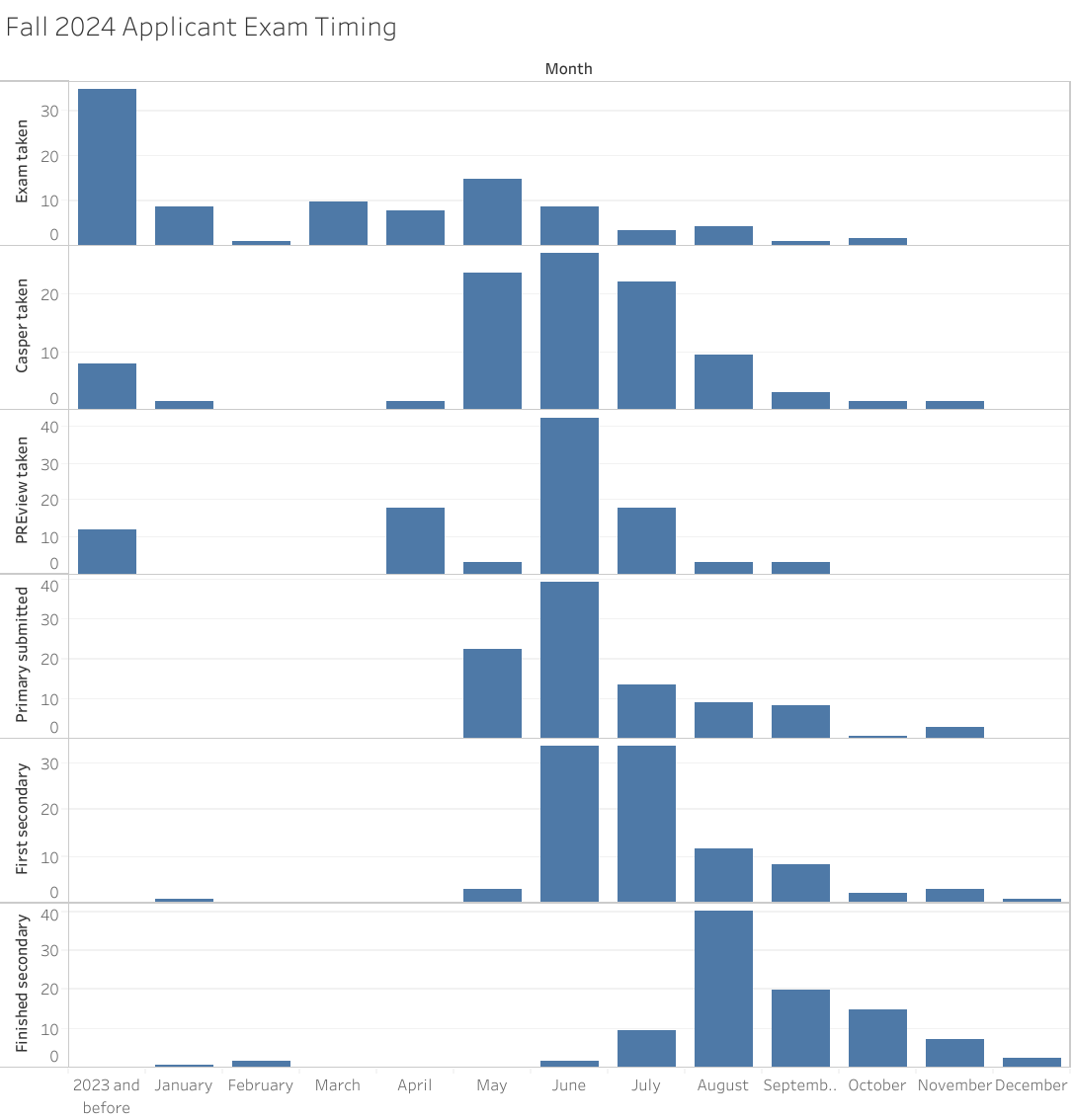
Situational Judgment Tests (Casper or AAMC PREview)
66 respondents took Casper, and 36 took AAMC PREview in the Fall 2024 survey. Their proportions resembled our earlier Situational Judgment Test Experience surveys in 2022 and 2023. (We will further analyze the 2024 SJT Experience survey in a future article.)
Many health professions programs that require Casper have also started to request the Duet assessment. About half of the Casper respondents took the Duet assessment (34 of 61, 55.7%), most within one day of taking their Casper assessment (21 of 33, 63.6%; within one week, 27 of 33, 79.5%). Most took Casper/Duet for the first time (27 of 35, 77.1%).
Casper respondents disclosed that they applied to programs that required or highly recommended taking the assessment for their application process, whether one program (10 of 61, 16.4%) or eight or more (17, 27.8%). In contrast, most PREview respondents disclosed they applied for up to three programs that required or highly recommended PREview (18, 62.1%).
Most respondents took their respective situational judgment tests in the early phase of the application cycle. Casper respondents’ peak exam months were May to July (46 of 63, 73.0%). PREview examinees preferred June (14 of 33, 42.4%), April (6, 18.2%), and July (6, 18.2%). Four PREview examinees (12.1%) had a prior score from 2023 or earlier.
SJT Specifics
Situational Judgment Tests (SJTs) have become increasingly common for health professional school admissions. Learn more about how these exams impact students and how to prepare for them.
Primary and Secondary Applications
Overall, respondents valued the advice to “apply early.” Most submitted their primary applications in May and June (82 of 132, 62.1%) and received secondary applications or school portal access soon after submission (June and July, 88 of 131, 67.2%) and completed submitting their last secondary/school-specific applications in August (51 of 127, 40.2%), September (25, 19.7%), and October (19, 14.6%).
Pre-Meds (AMCAS, AACOMAS, TMDSAS)
We highlight the differences in timelines among pre-med and pre-vet applicants since their timelines. Figure 2 shows the timeline among pre-med applicants and the three central application services (AMCAS, TMDSAS, and AACOMAS). Many applicants may be duplicated as they applied to more than one service, but most applicants complete their primary applications by June and all secondary applications by September.
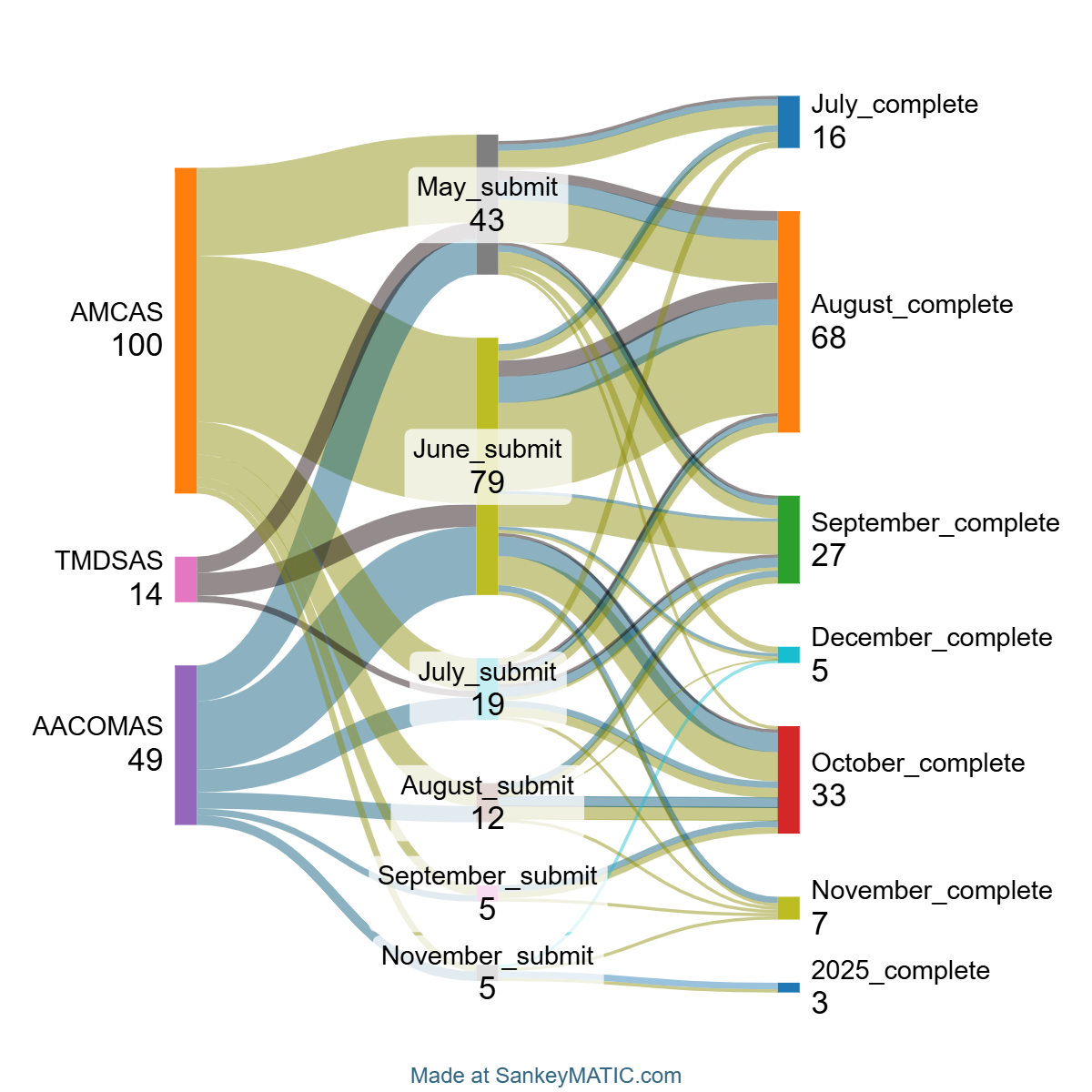
When the respondent cohort is broken down by the month their primary application was submitted (Supplemental Figure A), we notice a pattern where applicants who submit in May take longer to complete their secondaries (mostly by August); this is likely due to not receiving secondary prompts until June or because they are applying to a large school list. This pattern is similar to those who submit their primary application in June. By July, those submitting their primary applications receive secondaries quickly, usually within the same month.
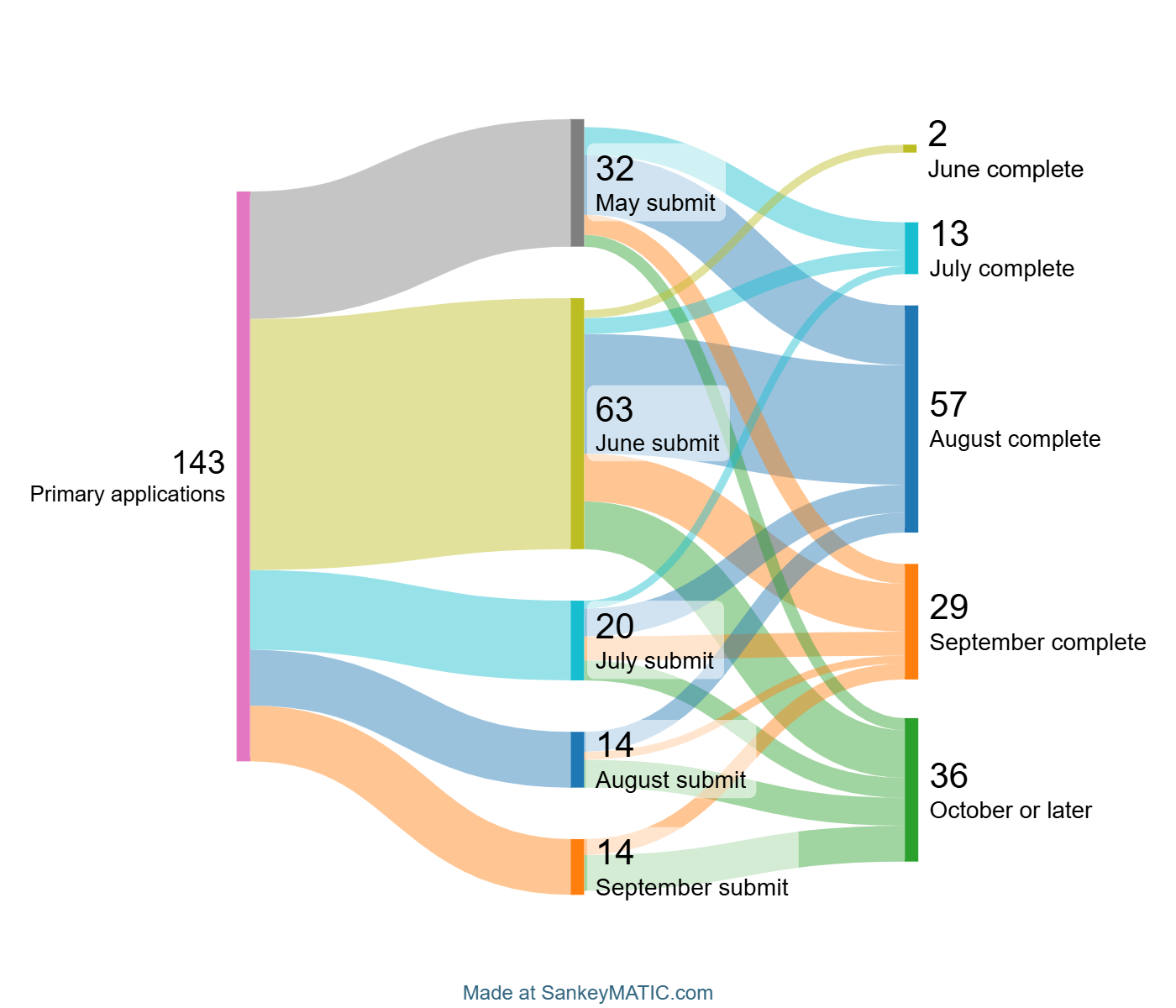
To confirm this observation, we focused on the respondents’ time to complete their secondaries (Supplemental Figure B). Our analysis shows that those who received secondaries beginning in May took longer to complete their applications (all secondaries), suggesting their intended program lists were longer. Some secondaries could not be completed until they were available in June or July. Pre-writing is generally advised to shorten the window between primary submission and completing all applications to one’s school list.
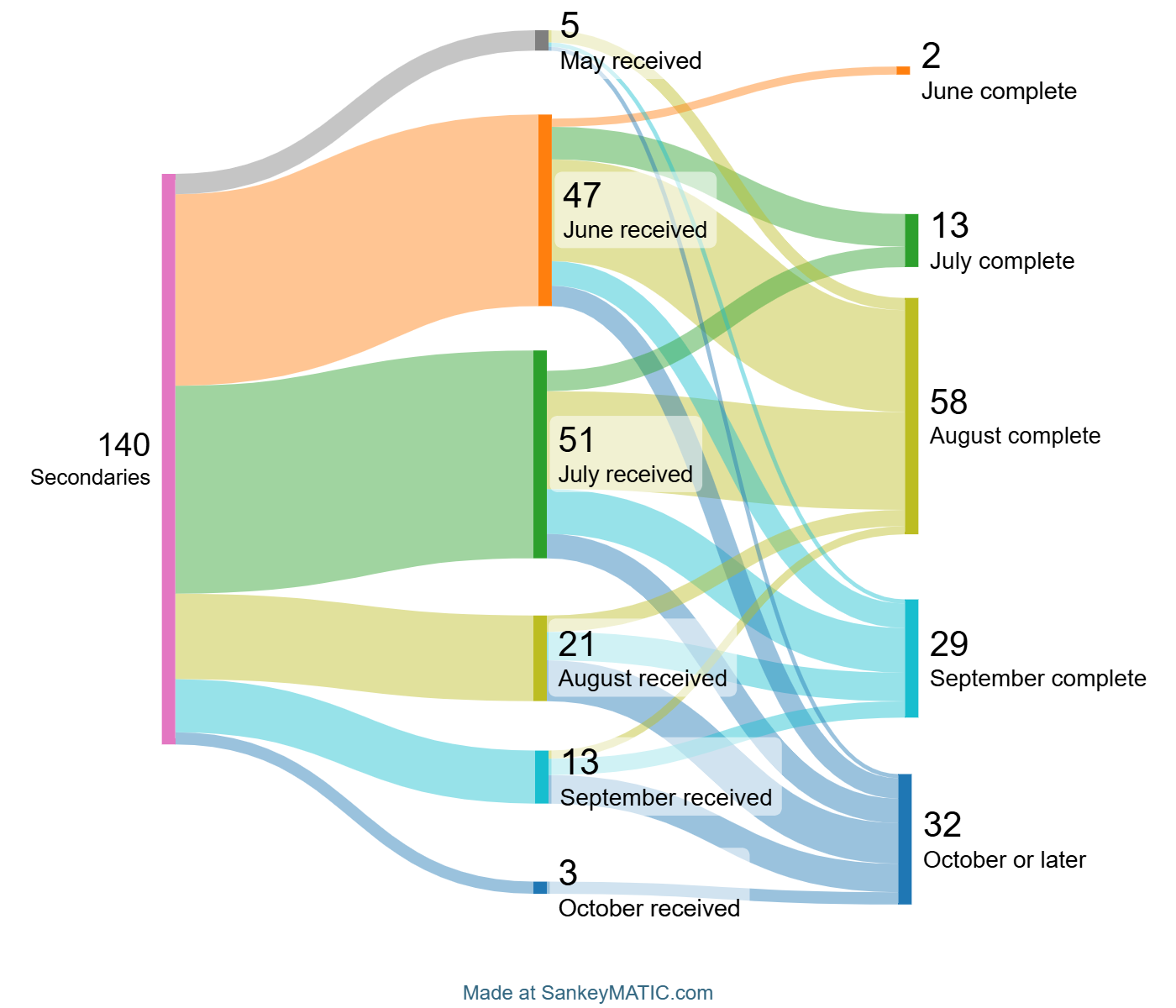
Takeaways: Pre-Med Timeline to Submit an Application
- About one-third of 2024-2025 applicants have an official score before March, and many may be re-applicants from prior cycles.
- Applicants also schedule exams for the spring (May, June, and July), which coincide with submitting their primary applications.
- Most applicants waited for their official exam scores before submitting their primary applications. However, roughly half of our respondents took their exam after submitting their primary application, which suggests they were disappointed with their initial scores relative to their desired program list.
- Most applicants schedule Casper exams in the spring (May, June, and July) and take their Duet assessment within the week following Casper (most by the next day).
- Respondents preferred scheduling PREview during the June window.
- Most submit their primary applications in the first months of the cycle (May and June). Secondary applications are first received in June.
- Most respondents completed secondary applications by August, when most programs issued their first interview invitations. About one-third completed their secondary applications by September and October.
Pre-Dentals (AADSAS, TMDSAS)
Like the AMCAS application cycle, AADSAS applicants can begin submitting in June (Figure 3). Most of our respondents submitted their AADSAS applications in June or July. Since dental schools do not all have extensive secondary applications, most respondents’ applications were complete by September.
One respondent applied to TMDSAS dental schools in June and was complete in June.
All predental applicants wait until December 15 for acceptance notifications (Dental School Decision Day: Your Guide).
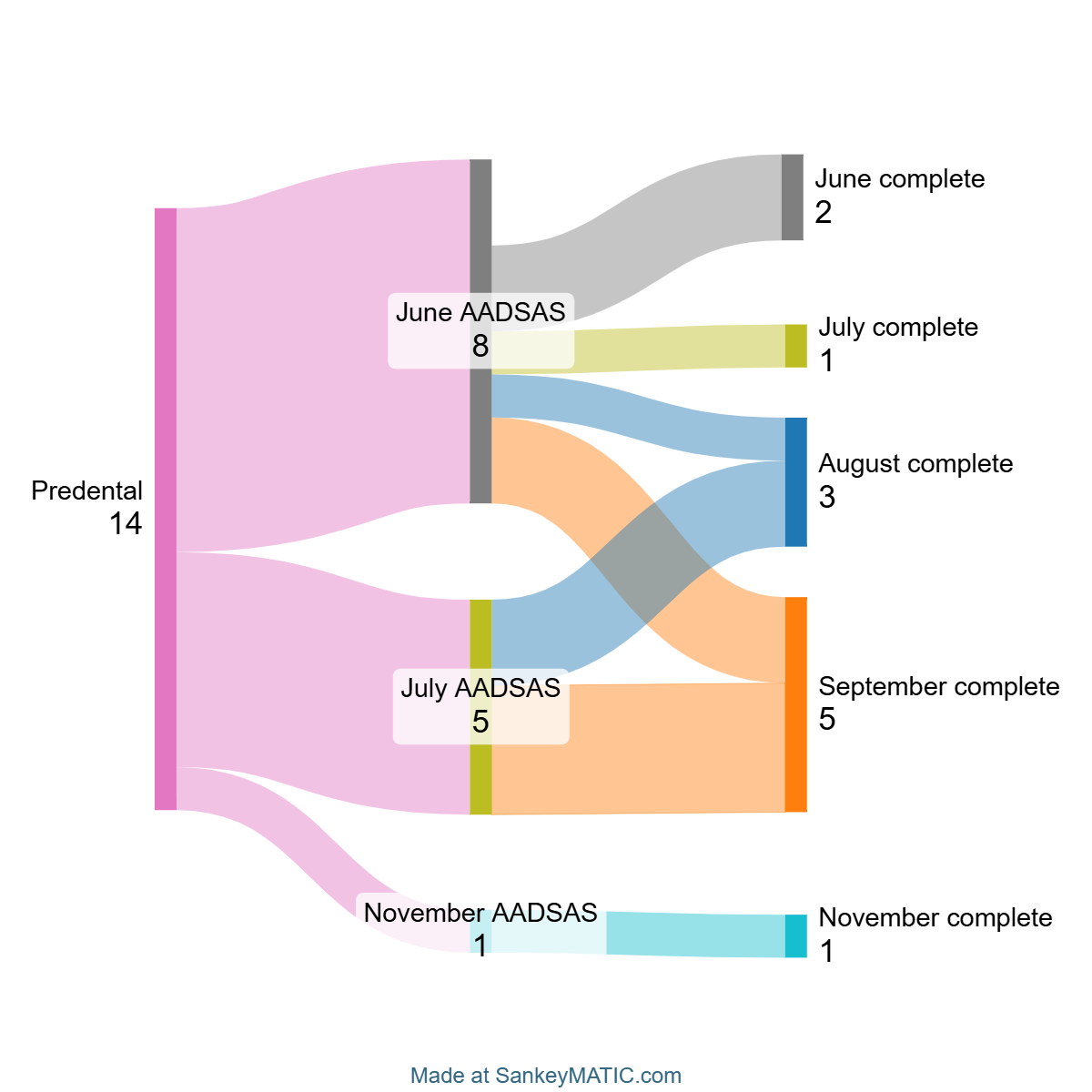
Pre-Vets (VMCAS, TMDSAS)
The VMCAS cycle opens in January and closes by mid-September (VMCAS Application Cycle Dates – Liaison). Unlike premed applicants, most of the 31 pre-vet applicants submitted their primary VMCAS closer to the end of the cycle (Figure 4). One pre-vet applied to TMDSAS in September (completed in September). Many vet schools will wait to open their school-specific portals until late spring, but most respondents complete any school-specific secondaries/portals in August or September, including securing solicited letters of recommendation.
As many vet schools no longer require the GRE or a standardized entrance exam, few respondents used test preparation. Among those that did, they prepared for up to two months during the summer (June, July, August).
Seven pre-vet respondents scheduled their Casper exams during the summer (July 2, August 2, September 3) to satisfy the Casper requirement at one or two vet schools. All respondents disclosed a third- or fourth-quartile result, and none took the Duet assessment.
After interviews are conducted in the late fall (October to January), vet schools will make admissions decisions in the winter (February or March), with a national commitment deadline of April 15. We plan to continue surveying their experience in the spring.
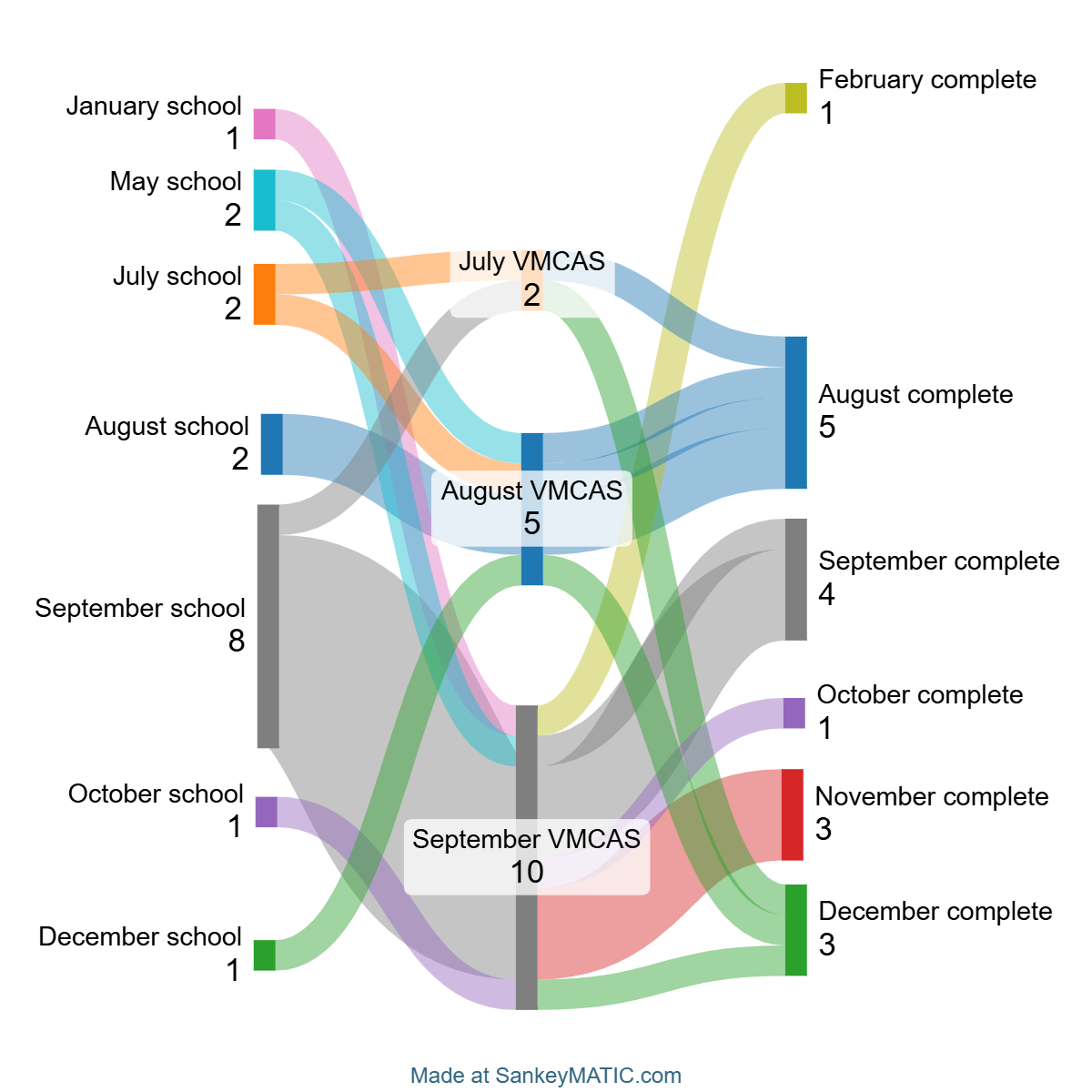
Understanding Your Purpose
Need help articulating your vision of yourself as a health professional? These articles can help guide you.
Time Management for Applicants
These results suggest that prehealth applicant experiences are influenced by messages from programs/schools that encourage early submission (medicine, dentistry) vs. deadline-oriented timelines (veterinary medicine and other health professions [professional experience]).
The spring months before the application cycle begins are critical to line up all the moving parts for early review of a strong application. Applicants must juggle multiple demands, including securing letters of recommendation/evaluation or completing the “committee letter” process. One must also take time to draft personal statements (articulating their impactful experiences, mission fit, and purpose) and secondary essays; university writing centers are generally overwhelmed. Applicants give interview preparation minimal attention until they are invited in the summer or later.
41.9% (57 of 136) of premed respondents leveraged online crowdsourced tools (CycleTracker, admit.org) to inform themselves about how medical school admissions offices act during the application process when sending secondary applications, opening portals, or issuing invitations to interview.
The fall semester remains a critical time to prepare for a strong application by attending application-focused seminars, recruitment fairs, campus visits, networking with mentoring organizations, and diving into meaningful experiences in research, clinic, or community service. Many also schedule taking their entrance exams during the fall semester, especially if they start or are involved in “growth year” experiences (outside of college).
Application Wisdom
Need more guidance on the application process? From secondaries to school lists to letters of recommendation, we have you covered.
Support HPSA for More Surveys
Did you find these results helpful? If so, please support HPSA surveys so we can continue to provide evidence-based insights about the health professional application experience.
